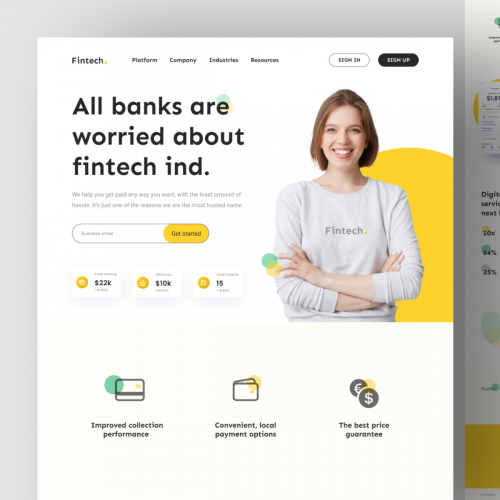Responsive Website Design for Effortless Viewing on Any Device
Responsive Website Design for Effortless Viewing on Any Device
Blog Article
Top Tips for Developing an Impactful Web Site Layout That Converts
In today's digital landscape, the value of an impactful website style can not be overstated, particularly when it involves converting visitors into consumers. To achieve this, one must consider a variety of variables, including recognizing the target audience, prioritizing user experience, and optimizing for mobile systems. The critical use of engaging call-to-actions and a well-defined visual power structure plays an essential role in guiding customers through their trip. As we discover these essential elements, it comes to be noticeable that the success of your website rests on even more than simply aesthetic appeal; it calls for a thoughtful approach to layout and performance.

Understand Your Target Market
Comprehending your target market is essential to reliable website design, as it prepares for developing an interesting individual experience. Determining who your customers are, including their demographics, preferences, and habits, makes it possible for developers to tailor the web site's web content, design, and capability to satisfy certain needs.
Carrying out complete market research is crucial in this procedure. Surveys, meetings, and analytics can offer valuable insights into user expectations and pain points. By assembling this information, designers can create user identities that stand for various sections of the target market, making sure that layout decisions are informed and relevant.
Additionally, understanding the target audience assists in choosing appropriate layout elements such as shade systems, typography, and images that resonate with customers. A site that talks directly to its audience cultivates a sense of connection and depend on, motivating longer brows through and greater conversion rates.
Inevitably, a user-centered approach to website style not only enhances user satisfaction but also supports company purposes by driving involvement and loyalty. By focusing on the requirements and preferences of the target market, a website can properly serve its function and achieve wanted end results.
Prioritize Customer Experience
To enhance the total effectiveness of a site, prioritizing user experience (UX) is crucial (Website Design). A well-designed UX makes sure that site visitors can browse the website effortlessly, discover information swiftly, and involve with content meaningfully. This causes raised user fulfillment and greater conversion prices
Begin by executing instinctive navigation. Menus ought to be logically structured, allowing customers to situate vital locations of the website with marginal initiative. Uniformity in style components, such as color plans and font styles, cultivates familiarity, which is crucial for maintaining user involvement.
In addition, consider the filling rate of your web site. A hold-up of simply a couple of seconds can bring about significant drop-offs, as individuals are less most likely to wait for a slow-loading web page. Simplifying pictures and enhancing code can boost performance and keep visitors.
By focusing on individual experience, you not just develop a more enjoyable setting for site visitors but additionally strengthen your brand's reliability. Eventually, an emphasis on UX is a financial investment in the long-lasting success of your site.
Maximize for Mobile Gadgets
Optimizing for smart phones is crucial in today's electronic landscape, where an increasing variety of customers have a peek here access websites with smart devices and tablet computers. A mobile-friendly layout not only enhances user experience but likewise plays a considerable function in boosting online search engine rankings. To achieve this, it is necessary to adopt a responsive style that instantly gets used to different screen sizes and orientations.

Packing rate is an additional vital element; mobile customers are commonly less person and expect rapid access to information. By prioritizing mobile optimization, you make certain that your web site remains competitive and properly engages a broader target market.
Usage Compelling Call-to-Actions
A web site's efficiency usually rests on its capacity to direct visitors toward desired activities, making compelling call-to-actions (CTAs) essential parts of design. CTAs work as the essential factors that direct individuals to involve with the site, whether that indicates buying, signing up for a newsletter, or downloading a source.
To develop efficient CTAs, clearness is paramount. Use succinct language that plainly communicates the action you desire the user to take.
In addition, you could try these out the design of CTAs need to attract attention without being meddlesome. Utilize contrasting colors and clear font styles to guarantee they catch attention. Additionally, consider utilizing directional hints, such as arrowheads or photos, to guide customers toward these buttons. By concentrating on these components, organizations can substantially enhance user involvement, driving conversions and inevitably attaining their website's goals.
Concentrate On Visual Pecking Order
Reliable web site style depends greatly on a well-structured visual hierarchy that overviews customers with material effortlessly. By organizing elements in a way that focuses on information, developers can improve individual experience and help try this website with decision-making. This includes utilizing dimension, shade, contrast, and spacing purposefully to attract interest to the most essential elements of a web page.
The use of larger font styles for headings and subheadings develops a clear difference in between different sections, allowing individuals to check content easily. Additionally, employing contrasting colors for buttons and calls-to-action can capture customer interest and urge interaction. Whitespace is one more necessary element; it avoids mess and makes it possible for users to focus on essential messages without diversions.
Images and graphics need to enhance the message while likewise adhering to the recognized power structure, reinforcing the general message (Website Design). Uniformity in layout components, such as color schemes and typography, further reinforces the visual power structure, making navigation intuitive

Final Thought
In verdict, effective web site design requires a detailed understanding of the target audience, prioritization of customer experience, and mobile optimization. Eventually, a well-executed web site layout serves as a critical part in driving customer actions and attaining business goals.
Report this page